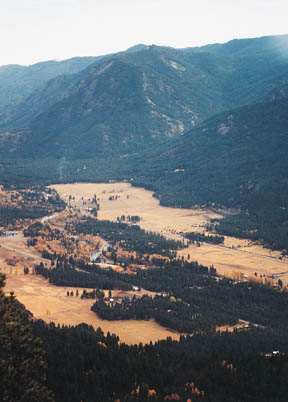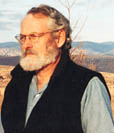|
|
|
| Subscriptions click here for 20% off! | E-Mail: info@rangemagazine.com |
PEACEFUL VALLEY
|
|||||||
|
|||||||
|
Doug and Grace Devin were new to ranching when they brought their
young family to the as-yet undiscovered Methow Valley in the mid-’60s.
They did not build ostentatious homes or fancy gates along the
highway. They simply buckled down to the business of raising cattle
and providing a life on the ranch for their son and daughter,
who are now actively involved in the family-ranch business. Steve
serves as a working, managing partner with his father. Betsy,
the community’s veterinarian, tends to herd health as well as
being the allotment rider for the cows’ summer range on national
forest. The entire family (including Skip Smith, Betsy’s husband) serves
on local boards, in community clubs, and attends church. Betsy
is active in 4-H leadership and is also a volunteer paramedic. The Devin Ranch near Mazama, Wash., is exactly what the cattle
industry needs today. A relatively young outfit by many generational-ranch
standards, the Devins have been raising commercial cattle in this
valley corralled by dramatic mountains and rock bluffs for more
than 30 years. The Devin Ranch ought to be exactly what the environmental movement
needs, as well. The presence of this last cattle ranch holdout
in the upper Methow Valley has kept a large portion of the area
undeveloped, in a place where every aspen grove hides a new retreat
for folks from the west side of the North Cascades. The Devins seek to improve not only their private land, but that
of their state and federal allotments, as well. They don’t overgraze
or overstock. They control weeds as best they can. They farm about
200 acres of hay and run a mid-sized cow/calf operation. However,
under new Endangered Species Act (ESA) regulations for salmon,
their water rights, a claim that dates back to 1908, are in jeopardy. “Without water, we can’t farm,” says Steve Devin. “Our agriculture
depends on it.” Water flows from Early Winters Creek into a main irrigation ditch
that serves 30 members in an association of which Steve is president.
The problem with Early Winters Ditch is that its diversion originates
on national forest, and the entire ditch flows through privately
owned land in the Methow Valley, which just happens to be the
major battleground in the state of Washington over salmon, water,
agriculture and environmentalism. Steve says, “I’ve heard National Marine Fisheries Services [NMFS
or “Nimfs”] basically say that they are going to start here setting
precedence, then work their way through the rest of the state.” Tellingly, state legislators have granted the Department of Ecology
$1 million to purchase or lease surface water rights from ditch
users, and has urged DOE to spend at least half of that amount
in the Methow Valley. There is definitely interest statewide in
the farming practices in this isolated valley, a four-hour drive
east of Seattle. The story began in 1997 through 1999, when spring Chinook salmon
and steelhead trout were listed as endangered. The result has
been that Skyline Ditch has been closed for two irrigating seasons
while three of its six miles have been encapsulated. Early Winters
Ditch was allowed to open late in ’99, and was forced to close
early in 2000. Farming practices have been inhibited by the inability
to predict the possibility of irrigation. Throughout the valley
all ditches have fish-screening devices, including the diversions
which lie on private land. Employees of the Department of Ecology
and NMFS (an enforcement agency within the U.S. Department of
Commerce) are common visitors to the area, and they are not here
to see the tourist-filled Old West town of Winthrop. It all comes down to fish and water and the amount of each in
the Methow, Chewuch and Twisp rivers which converge like a lopsided
turkey-track into the mainstem Methow, flowing 80 miles until
it empties into the Columbia. No one argues that there are fewer
fish, but there seem to be many contributing factors, including
changes in oceanic temperatures, harvesting of fish by commercial
and Native fishermen, and the presence of hydroelectric dams on
the Columbia River. It also comes down to research, what is called the “best available
science”–who has it and how to interpret it. Water users have
collected recent data on the river, paid for objective surveys,
and interviewed many fish biologists who lend credence to their
position. Dick Ewing is an unlikely champion for the farmer/rancher. He
moved to the Methow Valley in the mid-1980s with a background
in chemistry and no clear opinions concerning irrigation. He and
his wife, Pam, came to escape the hustle and bustle of Portland,
Ore., and ended up in the thick of the battle over water rights
and local control. He now serves as the unpaid chair of the Methow
Basin Planning Unit, a task force newly formed at the request
of the Okanogan County commissioners. “NMFS has not provided adequate
science to substantiate their position,” Ewing says, “and because
their information is scanty, it seems that what they are doing
is shooting high.” According to NMFS spokesman, Mike Grady, “The Methow has had more
studies done there than in most parts of the state. We had quite
a bit of information in front of us [when stream flows were established].
We can argue about this a long time but it’s not going to go away.” Irrigators in the Methow believe that there is plenty of water
in the river for spawning fish passage. They have proven through
scientific measurements of stream flow, by various research groups,
that diverted irrigation water only affects the flow of the rivers
by a fraction of the water diverted, since the water table recharges
most of the amount diverted within only one thousand feet from
the headgates in this geologically alluvial system. One researcher
compares the amount of diverted water to dipping water out of
a bathtub with a single measuring cup, and points to the resulting,
unnoticeable level. “We have fish passage and we have natural habitat. There are a
lot of fish hotel rooms, but they are not filled up,” claims Steve
Devin, “and this vacancy is not due to water users along the Methow.
Our river is waiting to welcome fish! The runs have simply changed.”
After ESA, NMFS required “biological opinions” which eventually
came in the form of “target stream flows” before ditches with
points of diversion on national forest were allowed to open. When
the flow of a stream falls to a certain level (cubic feet per
second), the irrigation ditches along that stream are turned off.
The target flows negated all water rights so that, in one fell
swoop, all management of water law given to Washington state in
1971, known colloquially as “first in time, first in line,” was
arbitrarily usurped by the U.S. government. This fact alone has
been the basis of a lawsuit in Pasco, Wash., and such litigation
is being considered by Okanogan County commissioners and ditch
users, as well. The complete story also requires an understanding of fish genetics
and a microscope. A dam located at the mouth of the Methow River
from 1915 through 1930 made the waters impassable to spawning
fish heading upstream. A national fish hatchery was initiated
in Winthrop to augment the lagging number of salmon. The breed
of spring Chinook salmon raised and released from the hatchery
was known as “Carson stock,” fish which migrated to the Pacific
Ocean and interbred for decades with varieties of spring Chinook
salmon which had been reared naturally or in hatcheries throughout
the Northwest. Thousands of Carson stock-cross fish return as their instincts
lead them to their upper Methow, Chewuch and Twisp spawning sites.
However, these are not the fish that NMFS wants to protect. Desiring to list a genus of fish close to what they believe is
the natural-rearing salmon (a fish basically eliminated for 15
years by the presence of the lower Methow dam), some biologists
arrived at a species called the “Methow Composite Stock.” This
fish is said to be indiscernible from the Carson stock except
through genetic testing. In the summer of 2000, the federal and
state agencies planned to club to death thousands of returning
hatchery-reared fish before they spawned because their eggs were
not the desired eggs. Protests from private citizens, including
many Native Americans, prevented this drastic measure, and the
eggs were collected and given away to other rivers and drainages. According to a NMFS website link to an executive overview of a
research project supported by the Department of Commerce, “variations
in ocean conditions–especially in water temperature and currents
and the associated biological communities–also contribute to the
rise and fall of salmon abundance, often thwarting the interpretation
of events in freshwater and the surrounding terrestrial systems”
(from “Upstream: Salmon and Society in the Pacific Northwest”). Many irrigators have been affected by this ongoing impasse with
NMFS. Dick Ewing on the Wolf Creek Ditch lost $30,000 worth of
young hardwood trees which died from lack of water. Sixty members
of the Skyline Ditch have lost crops and property values as their
canal has remained dry for two years. Ewing estimates that there
has been a four- to six-million-dollar impact upon the valley’s
irrigators in the last two years, in an area with an already strained
economy where many locals struggle through winters that bring
a scarcity of employment. The natural environment has also been affected. The valley was
once covered with productive ranches and farms. Weeds, such as
the ubiquitous Russian knapweed (known locally as “barnaby”),
have taken over all fields left unirrigated. A small example of
a dry ditch’s effect on wildlife is the scene of Grace Devin daily
filling drinking-water pans on her porch for native squirrels
when there is no water in the Early Winters Ditch. Another is
the carcasses along the highways of roadkill deer hit by vehicles
as they cross to drink water from the river. The Devin Ranch has felt financial impact as well. They lost their
fall pasture in 2000 and, as their cattle came off their summer
range, were forced to feed hay until they shipped their cattle
to winter range near Ephrata. In 1999, they plowed fields but
hesitated to plant without the assurance of their historic water
right. They have attended countless meetings. Doug and Grace have
driven hundreds of miles with trips to the state capital in Olympia
and the Okanogan County Courthouse to research water law and historic
use. They and Steve have met with state legislators and senators,
and spent hours on long-distance phone calls in the defensive
battle for a water claim which Doug and Grace paid for in increased
property values when they bought their ranch 30 years ago. They don’t have to do it. Their land is scenic. It lies in the
area of highest property values in the entire Methow Valley. They
could sell their land to developers, making available hundreds
of potential housing sites with arguably the best view in Washington.
The result would be that each member of the Devin family would
never have to work again if they didn’t want to. “Granted, we did not homestead here, as in the case of so many
generational ranches,” daughter Betsy explains, “but we did build
up this ranch and we would like to pass it down to our kids. Not
very many kids today have that opportunity.” Steve Devin never thought this would happen to them, “only because I know that what we’re doing here [farming and irrigating] is not a problem. I’d be the first one to help fish, I’d even turn off our water, but they [NMFS] are telling me to do things that don’t make any difference to fish survival, so we are making sacrifices for nothing. If spring Chinook salmon are endangered, and NMFS is being charged with the responsibility to prevent its extinction, as a private citizen I’m concerned. Agency biologists have logged hundreds of hours here and completely disrupted the community and ditches. Individuals have spent thousands of dollars proving their innocence, and it’s all not doing anything for spring Chinook recovery. I mean, it’s a Gary Larsen cartoon!” . |
|||||||
|
|||||||
|
Does irrigation harm salmon spawning habitat? Dick Ewing loudly
responds “No!” and cites scientific evidence and common sense
to support his opinion. “Consulting work done by Golder and Associates showed a much lower
target flow for Early Winters Ditch would not harm fish, but NMFS
refused this evidence. They also refuse to acknowledge a key study
completed in 1992 that documents positive correlation between
Methow fish productivity and irrigation diversions [“Production
and Habitat of Salmonids in Mid-Columbia River Tributary Streams”
by U.S. Fish & Wildlife Service]. Ken Williams, in his study of
steelhead, found that there was a higher productivity of fish
in the upper Columbia tributaries where irrigation was present
than in pristine coastal streams. “There is no reported fish mortality [due to low flows] during
the low stream flow months of September and October. The low flows
of January and February are roughly the same as flows in September
and October and 60 percent of the hatchable stock are killed in
the winter, when the irrigation is turned off. If there is a limiting
factor in the Methow for fish, it is the harsh winter conditions. “The real issue here is to document that we want to benefit fish, and that we have worked in a good faith effort to deal with the issues that NMFS has brought to the table. We would like to steer them in a better direction that will have more success.” . |
|||||||
|
|||||||
|
“The salmon issue here is out of control and it’s because the
Endangered Species Act [ESA] can give a federal agency so much
power and so much latitude that it can be abused. “For example, the bull trout are listed as threatened, but still
fall under the same ESA guidelines. However, bull trout are the
responsibility of the U.S. Fish & Wildlife Service. Their agents
came to this valley, prepared biological opinions in a responsible
and timely manner, used the best available science, and have been
decent to work with. NMFS has taken the same law, come into the
valley, and totally wreaked havoc in our community. Both agencies
are dealing with the same issues [flow and habitat] in the same
streams. “Of all the things that affect salmon survival, such as dams,
commercial fishing, Native fishing, oceanic conditions and Mother
Nature’s flows, NMFS is spending all of its time and money on
habitat conditions in the upper Methow where things haven’t changed
a bit. They are in their most natural state. “I’m told the Methow Valley is an area that has very complex hydraulic
interactions. Removing water someplace increases flows other places
at other times, and diverting water does not always really remove
measurable water. NMFS refuses to acknowledge these complexities.” Mike Grady “The Methow has received more money per capita than any basin
in Washington for water studies. There is an awful lot of information
on water in the Methow,” says Mike Grady from his office near
Seattle. “A lot of what we need to know is ‘What is a valid water
right?’ If we can true-up the water rights in the basin and if
people become as efficient as they can, my guess is we’re going
to be close to meeting needs for fish in the Methow.” Grady’s
family grew up on a farm in Illinois and he says they wouldn’t
talk to him again if he did something against agriculture. “The science is very straightforward. As you remove water from
the Methow, there is low water below the diversion. A lot of water
is lost to the system. With open canals, there is water lost to
evaporation. In irrigating a crop, evaporation occurs there. It’s
true that some water is returned back to the river through ground
water recharge, but how much, we don’t know. My job is to be sure
we’re using the best available science. “We will enforce the target stream flows next year, you bet! Eventually,
we will have ESA flows throughout the state of Washington. When
people get over the angst about a new law, I think you’ll see
progress over the next year. People will learn that you don’t
need to go out of business to comply with the Endangered Species
Act.” Ken Williams Ken Williams served for 28 years in Okanogan County, and coauthored
an almost 500-page report which took five years of study and two
years to prepare. He feels it is the most comprehensive body of
science available in respect to the Methow. “Our conclusion was that irrigation may benefit fish. Is there
historical evidence agreeing with our controversial conclusion
that irrigation may benefit fish? I have sifted the historical
record for such information without success until discovering
a new book [‘Methow Pioneer’ by Dale and Olive Mae Dibble] which
contained a quote from a son of a pioneer, who stated, ‘My father
told me that on Oct. 12, 1908, he waded across the Methow River...in
six inch shoes and didn’t get his feet wet.’ “This was before our ditches were in operation. This tells me that the rivers flow more now during the low water period than before the ditches started to flow.” Virginia Bennett is a freelance agricultural writer and cowboy poet from Winthrop, Wash. who “day works” for neighboring ranchers. |
|||||||
|
To Subscribe: Please click here or call 1-800-RANGE-4-U for a special web price Copyright © 1998-2005 RANGE magazine For problems or questions regarding this site, please contact Dolphin Enterprises. last page update: 04.03.05 |



